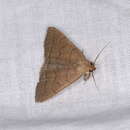ar
الأسماء في صفحات التنقل


Die Olivbraune Zünslereule (Zanclognatha tarsipennalis) ist ein Schmetterling (Nachtfalter) aus der Familie der Eulenfalter (Erebidae).
Die Olivbraune Zünslereule bildet zwei Generationen im Jahr, die von Ende Mai bis Anfang August und von Mitte August bis Ende September fliegen. Die Raupen sind ab Juli und im darauffolgenden Jahr Anfang Mai anzutreffen.[1]
Die Olivbraune Zünslereule (Zanclognatha tarsipennalis) ist ein Schmetterling (Nachtfalter) aus der Familie der Eulenfalter (Erebidae).
Zanclognatha tarsipennalis, the fan-foot, is a species of litter moth of the family Erebidae. It is found in Europe and east across the Palearctic to Siberia,[1] Amur, Ussuri, Japan, Taiwan, Korea and China.
The length of the forewings is 13–16 millimetres (0.51–0.63 in). Forewing narrower and greyer, less purple, than Polypogon lunalis Scopoli, 1763, sometimes with a yellowish flush; the inner and outer lines nearer together; the subterminal line simple, brown without any shade before, slightly concave outwards; the cell lunule obscurer; hindwing paler grey, the subterminal dark, strongly white-edged externally; the ab. bidentalis Hein. is paler grey, with a faint yellowish or rufous flush, the sub-terminal line of hindwing hardly angled. Larva dull grey; the dorsal line greyish black; tubercles black ringed with yellowish green; spiracles black; head black brown.[2]
The moth flies from May to October depending on the location.
The larvae feed on fallen leaves of European beech, oak and Rubus.
Zanclognatha tarsipennalis, the fan-foot, is a species of litter moth of the family Erebidae. It is found in Europe and east across the Palearctic to Siberia, Amur, Ussuri, Japan, Taiwan, Korea and China.

Zanclognatha tarsipennalis, l’Herminie de la vigne-blanche, est une espèce de lépidoptères (papillons) de la famille des Erebidae (ou des Noctuidae selon les classifications), qui vit en Europe sauf dans l'extrême Sud (Portugal, Grèce).
L'imago a une envergure de 26 à 32 mm. Il vole de mai à septembre suivant les régions en une ou deux générations.
Il vit dans des bois mixtes souvent humides.
Plantes-hôtes : la chenille se nourrit de feuilles sèches de plantes herbacées et d'arbres (chênes, hêtres, saules...).